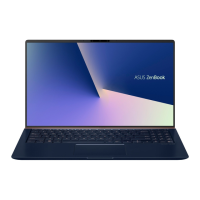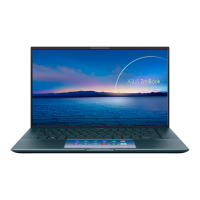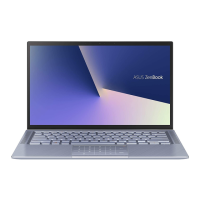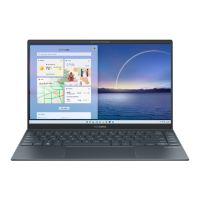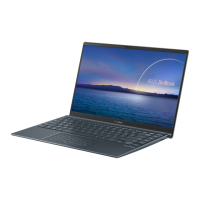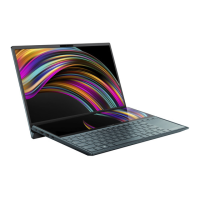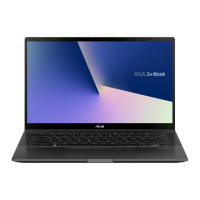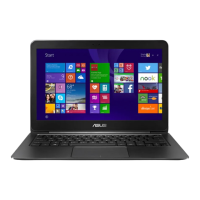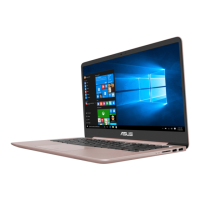
Do you have a question about the Asus UX410UA and is the answer not in the manual?
| Processor | Intel Core i5-7200U / i7-7500U |
|---|---|
| Storage | 256GB / 512GB SSD |
| Graphics | Intel HD Graphics 620 |
| Operating System | Windows 10 |
| Display | 14-inch Full HD (1920 x 1080) |
| RAM | 8GB DDR4 |
| Weight | 1.4 kg |
| Battery | 48Wh, up to 10 hours |
| Ports | HDMI, SD card reader |
| Wireless | 802.11ac |
| Bluetooth | Bluetooth 4.1 |
| Camera | HD webcam |
| Audio | ASUS SonicMaster |
Provides a detailed overview of the Notebook PC's hardware components, including different views and their features.
Details the components and features located on the bottom side of the Notebook PC.
Describes the ports and indicators found on the right side of the Notebook PC.
Details the ports and connectors located on the left side of the Notebook PC.
Instructions on how to connect the power adapter and charge the Notebook PC for the first time.
Explains touchpad gestures for pointer movement, clicking, scrolling, and zooming.
Details the commands triggered by function keys and special Windows keys on the keyboard.
Guides the user through the initial setup process for Windows 10 on the Notebook PC.
Explains how to use the Start menu as a gateway to programs, apps, folders, and settings.
Describes how to access and manage Windows apps displayed in tiled format on the Start menu.
Details how to move, resize, unpin, or pin apps to the taskbar from the Start menu.
Explains how to use Task View to switch between apps and desktops for efficient multitasking.
Describes the Snap feature for displaying apps side-by-side and snapping them into place.
Details how to access and use the Action Center for notifications and Quick Actions.
Lists useful keyboard shortcuts for launching applications and navigating Windows 10.
Step-by-step guide on how to connect the Notebook PC to a Wi-Fi network.
Instructions for pairing the Notebook PC with other Bluetooth-enabled devices for data transfer.
Explains how to turn Airplane mode on and off for wireless communication control.
Provides procedures for safely turning off or putting the Notebook PC into sleep mode.
Explains the Power-On Self-Test (POST) and the role of BIOS in system startup.
Details the procedure to enter the BIOS setup during POST using keyboard keys.
Guides on setting boot priorities and other configurations within the BIOS setup utility.
Describes how to set up administrator and user passwords for system security.
Explains how to lock or unlock interface functions like LAN and USB ports via BIOS.
Guides on setting a master password for secure access to the hard disk drive.
Explains how to save configuration settings and exit the BIOS utility.
Provides a step-by-step guide for updating the Notebook PC's BIOS using a flash drive.
Details how to restore or refresh the system to its original state or improve performance.
Guides on accessing and using available recovery options within Windows 10.
Offers practical tips for maximizing usage, maintaining performance, and securing data.
Answers frequently asked questions regarding hardware issues and provides troubleshooting advice.
Addresses common software issues and provides troubleshooting steps for the Notebook PC.
Details DVD-ROM, Blu-ray ROM drive capabilities, and internal modem compliance.
Covers CTR 21 approval for PSTN connection and network compatibility.
Details compliance with FCC rules regarding radio frequency interference.
Information on FCC RF exposure limits and CE mark compliance.
Details Industry Canada's radiation exposure limits and compliance.
Information on wireless channels and restricted bands in France.
Provides essential safety notices related to electrical connections and battery handling.
Covers power safety, REACH, copyright notice, and hearing protection.
Safety cautions for lithium-ion batteries, including explosion risks and disposal.
Details safety for optical drives, laser products, CDRH regulations, and coating.
Information on CTR 21 approval for connecting the built-in modem to public telephone networks.
Details ENERGY STAR, global environmental regulations, and ASUS recycling services.
Covers regional notices for California, Singapore, India, and battery disposal.
Official declaration of the product's conformity with relevant EU harmonisation legislation.

